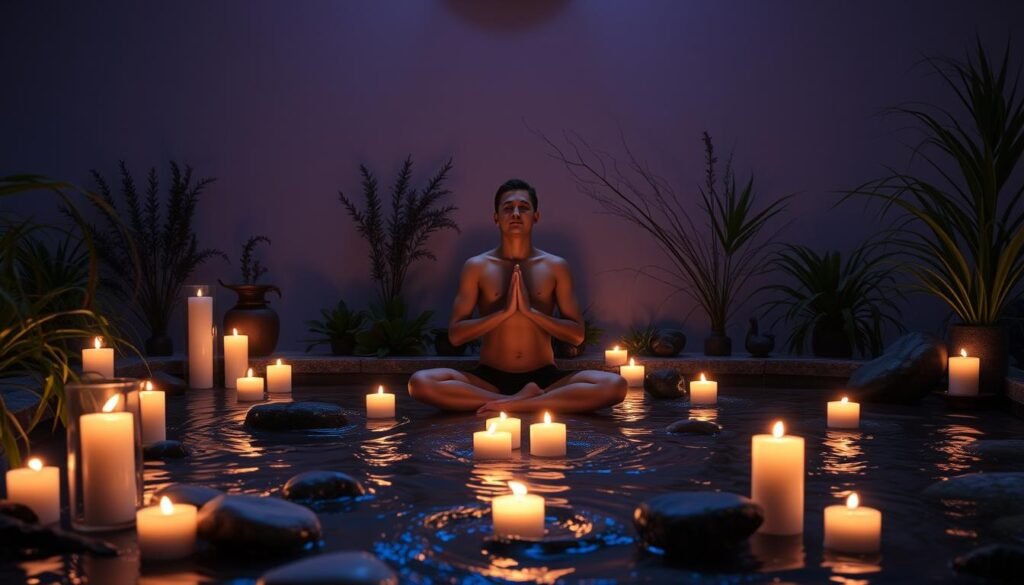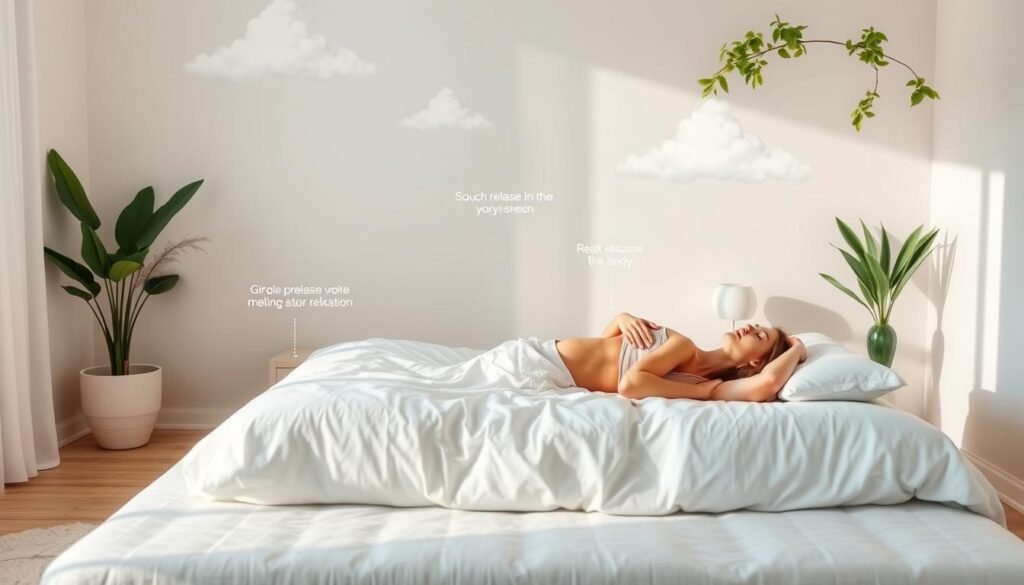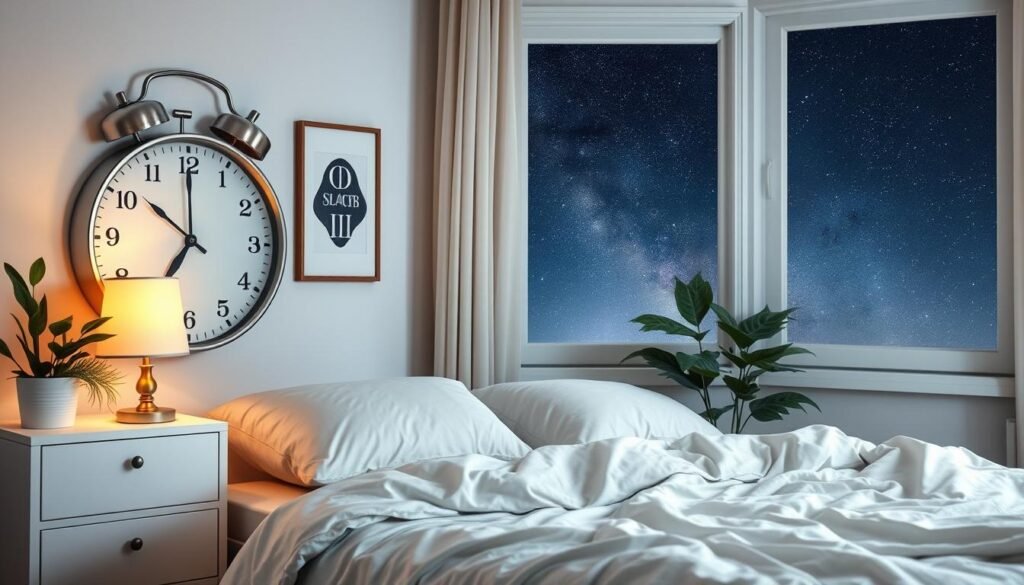Did you know that up to 70 million Americans struggle with sleep issues? It’s crucial to find effective ways to tackle these problems. Quick cognitive methods are now seen as great tools for improving sleep. They can change how we get ready for sleep, making it easier to fall and stay asleep.
Luc Beaudoin, a cognitive scientist, came up with these sleep tricks. They use ideas like thinking of calming scenes and practicing mindfulness to shift our focus away from what’s stressing us. By trying out different methods, people can get back to sleeping well and feeling better overall.
For more on how to fall asleep quicker, check out this link: tricks to help you fall asleep.
Key Takeaways
- Quick cognitive tricks can significantly improve sleep quality.
- Maintaining a consistent sleep schedule is vital for better rest.
- Visualization techniques can reduce unwelcome thoughts at bedtime.
- Mindfulness meditation has been shown to aid in relaxation before sleep.
- Physical signs of stress can hinder the ability to fall asleep.
- Cognitive strategies can create a calming pre-sleep environment.
Understanding Sleep Problems
Sleep disorders affect millions in the United States and deeply affect daily life. Problems like insomnia, sleep apnea, and anxiety are common. Understanding is key to treating these issues and improving health.
Common Issues Affecting Sleep
Many factors lead to sleep problems. Recognizing issues is the first step:
- Insomnia: Difficulty falling or staying asleep.
- Sleep Apnea: Breathing stops during sleep, causing loud snoring.
- Social Jet Lag: Internal clock and social life don’t match up.
- Performance Anxiety: Sleep stress makes it hard to stay asleep.
Knowing these problems is crucial to better sleep health.
Statistics on Sleep Disorders in the U.S.
Statistics show a worrisome state of sleep health in the U.S. Around 70 million Americans suffer from sleep disorders. The data shows how sleep issues affect life:
| Aspect | Details |
|---|---|
| Average Sleep Requirement for Adults | 7-9 hours per night |
| Teens’ Sleep Requirement | About 9.5 hours per night |
| Percentage of Insomnia Patients Improving with CBT-I | 70% to 80% |
| Chronic Sleep Issues Effects | Higher risk of high blood pressure, diabetes, and obesity |
| Impact of Technology | Long work hours, entertainment cuts into sleep |
Understanding these facts leads to better decisions for our sleep and health.
The Importance of Good Sleep
Getting enough sleep is key to staying healthy, both in mind and body. It keeps your mood positive and your mind sharp. It also makes you more productive. Rest helps your brain work well. This means better learning, memory, and keeping your emotions in check. The health benefits of sleep help everyone, no matter their age.
Physical and Mental Health Benefits
Sleep is super important for your well-being. It helps your body heal and recover from the day. While you sleep, your body works hard. It balances hormones, boosts your immune system, and lowers stress. Without enough sleep, you might feel tired, anxious, or have heart issues. Lack of sleep affects how you think and make decisions. This shows how closely tied sleep is to mental health.
Recommended Amount of Sleep
Adults should aim for 7 to 9 hours of sleep each night. But, the exact amount might change based on what you need or your daily activities. Getting this sleep helps solidify your memories. This happens during different sleep stages, like NREM and REM. Not sleeping enough can mess with your memory. This is common if you often skip sleep. To help with sleep problems, CBT can be a good choice. This highlights how crucial good sleep is for your brain and well-being. To learn more about sleep and memory, check out this resource.
| Benefit | Description |
|---|---|
| Memory Consolidation | Sleep supports the stabilization and retention of memories acquired during the day. |
| Emotional Regulation | Quality sleep aids in managing emotions and mitigating stress responses. |
| Cognitive Function | Restful nights enhance problem solving and creativity. |
| Physical Recovery | Good sleep promotes healing and overall bodily repair processes. |
Quick Cognitive Tricks for Sleep
Cognitive tricks are methods that help reduce anxiety before sleep. They can improve sleep quality a lot. By shifting focus from fast thoughts, it’s easier to fall asleep.
What are Cognitive Tricks?
Cognitive tricks help the mind settle before bed. One method is the Cognitive Shuffle by Dr. Luc P. Beaudoin. It involves imagining random objects. This helps the mind slow down for sleep. Another method, DIY-Serial Diverse Imagining (SDI), uses neutral words for mental distraction. This can help you fall asleep quicker.
How Cognitive Tricks Can Aid Sleep
These tricks can stop ongoing sleep issues. Take the DIY-SDI trick. You spell a word then think of objects for each letter. If a word is hard to picture, skip it. This keeps the exercise stress-free. Picturing a baby for “B” or an eagle for “E” is both fun and helpful.
Studies show these image-based methods really help improve sleep. They’re great for tackling sleep problems.
| Technique | Description | Benefits |
|---|---|---|
| Cognitive Shuffle | Visualizing various random objects. | Promotes relaxation and distracts from anxious thoughts. |
| DIY-SDI | Using neutral words to imagine items that start with each letter. | Improves sleep by keeping the mind engaged in non-stressful imagery. |
| mySleepButton App | An app for structured cognitive shuffle sessions. | Helps users fall asleep with guided imagery and relaxation. |
Using cognitive tricks can help you sleep better when usual methods don’t work. If sleep problems continue, it’s a good idea to see a doctor.
Breathing Techniques for Relaxation
Relaxation is key for good sleep, and breathing exercises can greatly help. These exercises, like 4-7-8 breathing, make it easier to fall asleep by lowering your heart rate and stress. This method is especially powerful in making you calm and improving sleep quality.
The Science Behind Controlled Breathing
Diaphragmatic breathing, a stress-reduction method, activates the body’s relaxation response. Stress ramps up your fight-or-flight response, hindering sleep. By practicing controlled breaths, you can calm down. This results in less anxiety and a better sense of well-being.
Techniques: 4-7-8 Breathing Method
The 4-7-8 technique, based on ancient yoga, focuses on regulating breaths. You inhale for four counts, hold for seven, then exhale for eight. Studies show this regular practice decreases stress, aiding sleep. Dr. Melissa Young suggests doing this twice daily, three cycles each, for stress relief.
| Technique | Description | Benefits |
|---|---|---|
| 4-7-8 Breathing | Inhale for 4 seconds, hold for 7, exhale for 8 | Reduces anxiety, lowers heart rate |
| Diaphragmatic Breathing | Breathe deeply into the belly | Enhances relaxation, improves breathing efficiency |
| Box Breathing | Inhale, hold, exhale and hold, each for equal counts | Improves mood, reduces stress |
Regular practice of these techniques can help your body manage stress better. It encourages a natural relaxation process for better sleep. 
Visualizing Calm Scenes
Visualization methods can help you sleep better by easing your mind. Imagining peaceful places lets you leave the day’s stress behind. Your mind can go to calm places, making it easier to fall asleep.
How Visualization Helps Sleep
Visualization draws your mind away from worries and stress. Seeing calming scenes in your mind, like beautiful landscapes, helps you relax. These images make it easier to drift off to sleep.
Using visualization, you can fight the stress that keeps you awake. It helps stop negative thoughts, allowing for a peaceful entry into sleep.
Effective Visualization Techniques to Try
Try these visualization methods for better sleep:
- Nature Scenes: Imagine lying on a beach with the sun warming your skin and waves crashing softly.
- Progressive Relaxation: Think of your body relaxing piece by piece, with each breath easing tension away.
- Calming Color Imagery: Picture a soothing color spreading around you, making you feel at ease.
- Cognitive Shuffling: Think of random, light thoughts, like different animals or foods, to gently calm your mind.
Regular practice can improve your sleep quality significantly. Everyone can find visualization techniques that work best for them.
Progressive Muscle Relaxation
Progressive muscle relaxation (PMR) is a method that helps reduce stress in your body and mind. It’s really good for helping you sleep better. The technique was created by Edmund Jacobson, an American doctor, in the 1930s. By tensing and then relaxing your muscles, PMR makes you feel more relaxed and can improve your sleep quality.
Understanding Progressive Muscle Relaxation
PMR is great for people struggling with anxiety issues like generalized anxiety disorder or social anxiety disorder (SAD). It has many health perks, such as lowering stress hormone levels and making your mind clearer. Using this method can help you deal with stress better, sleep more soundly, and ease pain in places like your neck and lower back.
Step-by-Step Guide to PMR
To get the full benefits of PMR, here’s what you should do:
- Choose a quiet, comfy spot where you won’t be disturbed.
- Take about 5 slow, deep breaths to get centered.
- Start with your feet. Make the muscles tight for five seconds, then relax. Stay relaxed for 15 seconds.
- Work your way through these muscle groups: lower leg and foot, entire leg, hands, entire arms, buttocks, stomach, chest, neck and shoulders, mouth, eyes, and forehead.
- Keep things peaceful. Practice PMR twice daily for one to two weeks for the best results.
- Think about using relaxation CDs or guided scripts to improve your practice.
Studies show that doing PMR often can make your sleep better and reduce anxiety, bringing peace and calm. Spending around 15 minutes per session can really lower your stress levels. This technique helps you relax deeply, giving you the tools you need for better sleep.

Mindfulness and Meditation Techniques
Adding mindfulness techniques for sleep through meditation can make falling asleep easier. Structured and casual meditation helps focus on the now, calming the mind. This part talks about these technique’s benefits and easy meditation practices for nighttime.
Benefits of Mindfulness for Sleep
Mindfulness has many pluses for better sleep. Some main benefits are:
- Meditation cuts down the time it takes to fall asleep.
- It aids in longer, deeper sleep by slowing breathing and reducing heart rates.
- Guided sleep meditations can boost overall sleep quality.
- Using these practices often can improve sleep routines.
Simple Meditation Practices to Implement
Adding meditation to your bedtime routine is simple. Try these effective methods:
- Guided Sleep Meditation: Involves breathing exercises, like counting breaths, for sleep.
- Mindful Body Scanning: Relaxes different body parts step by step for deep calm.
- Visualizations: Picturing peaceful scenes to get the body ready for sleep.
- Cognitive Shuffling: Thinking of random objects or situations to clear the mind and sleep better.
These meditation practices can greatly help with getting restful sleep. Mixing different techniques, like word and picture shuffling, makes falling asleep faster and more pleasant.
| Technique | Description | Benefits |
|---|---|---|
| Guided Sleep Meditation | Uses spoken instructions for easier relaxation. | Enhances sleep quality and soothes the atmosphere. |
| Mindful Body Scanning | Focuses on relaxing body sections one by one. | Releases stress and encourages deep calm. |
| Cognitive Shuffling | Thinks of unrelated words or stories to calm the mind. | Lowers stress and helps fall asleep quicker. |
Establishing a Sleep Routine
A good sleep routine is key to better sleep quality. It tells our bodies it’s time to calm down. By planning nights around calming activities, we get ready for rest. This follows what sleep experts say about the importance of bedtime routines.
The Role of Consistency in Sleep Habits
Being consistent with when we sleep and wake up is crucial. It keeps our body’s clock running smoothly. Experts say adults need at least seven hours of sleep.
This helps us stay on a natural schedule. With more people having trouble sleeping, a good routine can reduce bedtime anxiety.
How to Create a Relaxing Pre-Sleep Routine
To ease into sleep, a relaxing routine helps. Here are tips for better night habits:
- Limit screen time: Avoid screens an hour before bed to cut down blue light.
- Incorporate relaxation techniques: Try reading, doing gentle stretches, or meditating.
- Create a comfortable environment: Make sure your bedroom is cool, dark, and quiet.
- Explore natural remedies: Herbal teas can help you relax.
Combining these strategies by creating a bedtime routine matches your needs and goals. Sticking to them can lead to better sleep and health.

Technology and Sleep Hygiene
In our lives today, technology is everywhere, including its impact on how we sleep. Knowing how tech affects sleep is key to resting better at night. One big problem is the blue light from smartphones, tablets, and computers. It can mess with our melatonin production and make it hard to fall asleep.
The Impact of Blue Light on Sleep
Studies show that blue light before bed is bad for our body clock. Our sleep and wake cycles depend on natural light. The AASM advises turning off gadgets 30 to 60 minutes before bedtime. Doing this can really improve your sleep quality.
Best Practices for Reducing Tech Distractions at Night
For better sleep, we can make our bedrooms more tech-free. The table below shares ways to reduce tech use before bed for improved sleep:
| Practice | Description |
|---|---|
| Implement a Screen Curfew | Turn off all electronic devices at least 30-60 minutes before bedtime to minimize blue light exposure. |
| Create a Relaxing Environment | Make sure your bedroom is dark, cool (ideally 65-68°F), and comfy for the best sleep. |
| Use Night Mode Settings | Switch on night mode on your devices to cut down on blue light at night. |
| Limit One Screen at a Time | Don’t use multiple screens before bed to lessen mental stress and distractions. |
| Explore Relaxation Apps | Try apps made for mindfulness and relaxation to get ready for sleep. |
By using these tips, you can beat the bad effects of technology on sleep. Putting these ideas into action can help you feel better overall.
Conclusion
Many people know the struggle of trying to get enough sleep. In fact, about 43% of Americans say they don’t often get a good night’s sleep. Using simple brain tricks for better sleep can make a big difference. These tricks deal with the thinking patterns that stop us from sleeping well.
Mindfulness, picturing peaceful images, and relaxing your muscles bit by bit are some techniques that can help. They fit easily into our daily lives. This means we can improve our sleep without much change to our routine.
It’s really important to try these sleep improvement methods. Sticking to a regular sleep schedule and having a calming routine before bed work well. They are better than using medications for long-term sleep issues. A lot of people suffer from sleep problems, so these tricks are key to sleeping well regularly.
Taking these steps helps us take charge of our sleep health. With the right methods and a focus on relaxing, anyone can start to tackle sleep problems. This leads to enjoying the refreshment that comes from good sleep.